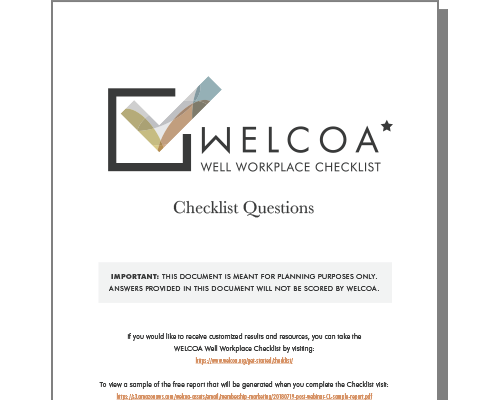During the COVID-19 pandemic, people spent a lot of time isolated and indoors, which helped foster an environment where some people now feel lonelier than ever. The result is a loss of social connectedness—the degree to which people feel the social connections and relationships in their lives to satisfy their wants and needs. When social…
Your Welcoa membership has expired.
Questions to Strengthen Your Employee Wellness Program Strategy
As corporate wellness professionals, many of us view the planning phases of our programs as the most difficult and unpleasant parts of our jobs. How do I plan a meaningful wellness initiative to achieve what I want to achieve? What should my goals be? How do I improve my existing wellness program?
If you struggle with any of these questions, it may feel easier to “just start small” by offering a few resources, activities or challenges — or to improve your program by adding new and fresh programs each year. For example, if you offered a series of lunch and learns last year, that’s a good thing. If this year you offer a walking challenge on top of the lunch and learn, that’s an even better thing, and so on. The problem with approaching program planning in this way is that it often leads to a crisis of purpose in our wellness programs where we have a hard time answering some pretty important questions. What are we trying to achieve? What outcomes were we hoping for? And worse yet, how do I even know how to measure the extent to which we are achieving our goals?
If you want to avoid this kind of pain, here are 5 questions you can ask as you begin to develop your strategy (and a suggested timeline for asking them).
6-9 Months Before the Beginning of a Program Year
What are we trying to achieve for the organization with our wellness program?
The best place to start when developing your strategy is to ask your leadership — your CEO, c-suite, departmental leaders and managers — what outcomes matter most to them. It seems straightforward, and you may think you already know the answer; however it is important to ask not just one set of business leaders in your organization, but a variety of them.
Your CEO may care about healthcare dollar savings, but the managers in your organization may care about something else entirely like attracting the best talent or improving creativity or performance. If you understand the full spectrum of priorities within your organizations’ leadership, you can set goals and craft messaging that will be relevant to the people who are determining your organizations’ culture and employee experiences.
6 Months Before the Beginning of a Program Year
What employee or departmental voices should be included in the planning process?
Not everyone in an organization experiences work in the same way. Different departments, job types, and levels within the organization have different experiences and interests. You don’t have to be an expert on all of them, but you do want to make sure you have a way to include representatives from different areas of the organization on your wellness planning team. Also, it may be helpful to think about what other areas in your organization may be focusing on the same goals that you are. Who knows? You may find out that another area of the organization is providing a resource or managing an initiative that you can plug into to achieve your (and your leadership’s) wellness program goals!
3-6 Months Before the Beginning of a Program Year
What lifestyle goals are employees already trying to achieve?
When planning your wellness strategy, it is important to understand what matters to the people in your organization. Apart from what the organization is trying to achieve, setting goals that are in alignment with your employees’ individual goals for their health will ensure that you provide meaningful resources and programs that (hopefully!) your employees will want to take part in. According to Judd Allen from the Human Resources Institute, every year about 80% of employees set a healthy lifestyle goal. Unfortunately, only 20% of those employees actually achieve those goals each year. Remembering that your employees already care about their health, and creating programming that reduces barriers to achieving the goals they have for themselves is a great planning strategy. Try administering an employee needs and interests survey to answer some of these questions. For example, if you find out a core value for the majority of your employees is spending more time with family, building family fitness activities or flex time policies into your wellness program might be a goal of your wellness plan.
1-3 Months Before the Beginning of a Program Year
How is the workplace environment working against you?
In what ways is your workplace environment out of alignment with the goals you want to achieve for your wellness program? In what ways is your environment out of alignment with the goals employees want to achieve for themselves? Asking these questions directly of your employees via survey or focus group is a great way to determine what employees currently think and feel about the environment and culture in which they work. You might also want to find out from them what supportive or unsupportive features for wellness currently exist in the work environment and culture.
For example, if employees want to be more active during the workday, but there is nowhere onsite and nowhere safe nearby to take a run or walk, it will be difficult for employees to make that change. Is there a basement or service floor in your building that could be converted to a track? Could more flexible work policies allow employees to run to the gym over a lunch break? Consider these kinds of changes when setting goals and determining your strategic plan.
Before, During and After Your Program Year
How will I evaluate whether I am successful?
The best way to ensure you will always know whether you were successful and, even more importantly, communicate that success to your leadership, is to decide how you will measure program impact before you roll it out. Apart from scheduling and budgeting, make an evaluation plan part of your annual planning process. If you plan to roll out an educational series on plant-based diets, what are you hoping the outcome will be? Let’s say that your aim is that the program will be well-attended, participants will be pleased with the offering, and employees will begin working more fruits and vegetables into their diets. If that’s the case, you may need to plan to measure registration numbers to gauge interest before the program begins, give out satisfaction surveys during the series, and then measure changes in fruit and vegetable consumption within your onsite food services after the program has ended. The most important thing is to know what success looks like and how you will measure it before you start your program year!
It may not sound like a good use of your very limited (and precious!) time to do a lot of this planning and goal setting work upfront, but doing so will ultimately lead to better outcomes for your program and for the employees of the organization you serve. If you want to understand whether your wellness initiative is on track toward answering these questions and implementing a successful wellness program, WELCOA has created the Well Workplace Checklist™ to make things even easier. Your Checklist results dashboard will help you celebrate and report out how you are doing today and give you custom recommendations and resources for making improvements in the future!
How well is your organization supporting employee wellness? Complete the Checklist and find out where you shine, and where you have opportunities to improve.

[Planning Template]
Wellness Program Checklist Questions
Use these questions to help you prepare to take the Well Workplace Checklist online. Complete these worksheets with all stakeholders for wellness to help determine your strategic wellness goals.

About the Author
Sara’s purpose is helping people fulfill their highest potential in work and life through corporate health promotion. She has launched award winning wellness programs, created new wellness products, and engineered work environments to create cultures of health across multiple industries. At WELCOA, she is responsible for conceptualizing the strategy behind new innovative products, developing new content, and maintaining relationships with WELCOA’s partnerships. She sits on the Johns Hopkins Mental Health in the Workplace Advisory Council, the CDC Workplace Health Resource Center Steering Committee and the WELCOA Well Workplace Process Advisory Council.




